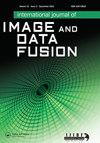Synergistic retrievals of leaf area index and soil moisture from Sentinel-1 and Sentinel-2
IF 1.8
Q3 REMOTE SENSING
International Journal of Image and Data Fusion
Pub Date : 2022-12-01
DOI:10.1080/19479832.2022.2149629
引用次数: 1
Abstract
ABSTRACT Joint retrieval of vegetation status from synthetic aperture radar (SAR) and optical data holds much promise due to the complimentary of the information in the two wavelength domains. SAR penetrates the canopy and includes information about the water status of the soil and vegetation, whereas optical data contains information about the amount and health of leaves. However, due to inherent complexities of combining these data sources there has been relatively little progress in joint retrieval of information over vegetation canopies. In this study, data from Sentinel–1 and Sentinel–2 were used to invert coupled radiative transfer models to provide synergistic retrievals of leaf area index and soil moisture. Results for leaf area are excellent and enhanced by the use of both data sources (RSME is always less than and has a correlation of better than when using both together), but results for soil moisture are mixed with joint retrievals generally showing the lowest RMSE but underestimating the variability of the field data. Examples of such synergistic retrieval of plant properties from optical and SAR data using physically based radiative transfer models are uncommon in the literature, but these results highlight the potential for this approach.Sentinel-1和Sentinel-2叶片面积指数和土壤水分的协同反演
摘要由于合成孔径雷达(SAR)和光学数据在两个波长域中的互补性,联合检索植被状况具有很大的前景。SAR穿透树冠,包括有关土壤和植被水分状况的信息,而光学数据则包含有关树叶数量和健康状况的信息。然而,由于组合这些数据源的固有复杂性,在植被冠层信息的联合检索方面进展相对较小。在这项研究中,Sentinel-1和Sentinel-2的数据被用于反演耦合辐射传输模型,以提供叶面积指数和土壤湿度的协同反演。叶面积的结果非常好,并且通过使用这两个数据源得到了增强(RSME总是小于,并且相关性比同时使用这两种数据源时更好),但土壤湿度的结果与联合反演结果相混合,通常显示出最低的RMSE,但低估了现场数据的可变性。使用基于物理的辐射传输模型从光学和SAR数据中协同检索植物特性的例子在文献中并不常见,但这些结果突出了这种方法的潜力。
本文章由计算机程序翻译,如有差异,请以英文原文为准。
求助全文
约1分钟内获得全文
求助全文
来源期刊

International Journal of Image and Data Fusion
REMOTE SENSING-
CiteScore
5.00
自引率
0.00%
发文量
10
期刊介绍:
International Journal of Image and Data Fusion provides a single source of information for all aspects of image and data fusion methodologies, developments, techniques and applications. Image and data fusion techniques are important for combining the many sources of satellite, airborne and ground based imaging systems, and integrating these with other related data sets for enhanced information extraction and decision making. Image and data fusion aims at the integration of multi-sensor, multi-temporal, multi-resolution and multi-platform image data, together with geospatial data, GIS, in-situ, and other statistical data sets for improved information extraction, as well as to increase the reliability of the information. This leads to more accurate information that provides for robust operational performance, i.e. increased confidence, reduced ambiguity and improved classification enabling evidence based management. The journal welcomes original research papers, review papers, shorter letters, technical articles, book reviews and conference reports in all areas of image and data fusion including, but not limited to, the following aspects and topics: • Automatic registration/geometric aspects of fusing images with different spatial, spectral, temporal resolutions; phase information; or acquired in different modes • Pixel, feature and decision level fusion algorithms and methodologies • Data Assimilation: fusing data with models • Multi-source classification and information extraction • Integration of satellite, airborne and terrestrial sensor systems • Fusing temporal data sets for change detection studies (e.g. for Land Cover/Land Use Change studies) • Image and data mining from multi-platform, multi-source, multi-scale, multi-temporal data sets (e.g. geometric information, topological information, statistical information, etc.).
 求助内容:
求助内容: 应助结果提醒方式:
应助结果提醒方式:


